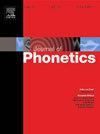Contextual and paradigmatic effects on suspended contrast across generations: The case of Cantonese pinjam revisited
IF 2.4
1区 文学
0 LANGUAGE & LINGUISTICS
引用次数: 0
Abstract
Suspended contrast refers to the phenomenon whereby sound change brings two phonemes into such close approximation that semantic contrast between them is suspended for native speakers of the language, without necessarily leading to complete merger or neutralization. The existence of suspended contrasts not only raises questions about the nature of the phonetics-phonology interface, but also for theories of sound change that assume sound change is biased toward selective maintenance of phonemes that contribute more to distinguishing existing lexical items in usage. Small differences supporting a suspended contrast are expected to disappear quickly given that they do not serve any apparent communicative functions. It remains a question whether a contrast can be suspended for a considerable period of time. This study revisits a case of suspended contrast in Cantonese between the lexical high rising tone and the high rising tone derived through morphological tone change (pinjam). We use an apparent-time approach to investigate the diachronic trajectory of this neutralization by comparing the distribution of this suspended contrast along both F0 and durational dimensions across two generations of Hong Kong Cantonese speakers. While this case of suspended tonal contrast has been in circulation for almost a century, our findings suggest that the distinction might be disappearing among the younger speakers. Only older speakers maintain a distinction between the lexical and derived rising tones, albeit in very restricted tonal contexts. The fact that this suspended tonal contrast exhibits great sensitivity to contextual and morphological influences may help explain the progression of this case of merger-in-progress.
语境和范式对跨代悬浮对比的影响:广东弹词案例再探
悬置对比指的是一种现象,即语音变化使两个音素非常接近,对于母语人士来说,它们之间的语义对比被悬置,而不一定导致完全合并或中和。悬置对比的存在不仅对语音-音系界面的本质提出了质疑,而且也对语音变化理论提出了质疑,这些理论认为语音变化倾向于选择性地维持音素,这些音素更有助于区分使用中的现有词汇。支持悬置对比的微小差异预计会很快消失,因为它们没有任何明显的交际功能。是否可以在相当长的一段时间内暂停对比仍然是一个问题。本研究重访了广东话词性高升调与词性语调变化引起的高升调的悬空对比。通过比较两代香港粤语使用者在F0和持续时间维度上的悬浮对比分布,我们采用明显时间方法来研究这种中和的历时轨迹。虽然这种暂停音调对比的情况已经流传了将近一个世纪,但我们的研究结果表明,这种区别可能正在年轻的说话者中消失。只有年长者才会区分词性的和派生的上升声调,尽管是在非常有限的声调上下文中。这种暂停的音调对比对语境和形态的影响非常敏感,这一事实可能有助于解释这种合并进行中的情况的进展。
本文章由计算机程序翻译,如有差异,请以英文原文为准。
求助全文
约1分钟内获得全文
求助全文
来源期刊

Journal of Phonetics
Multiple-
CiteScore
3.50
自引率
26.30%
发文量
49
期刊介绍:
The Journal of Phonetics publishes papers of an experimental or theoretical nature that deal with phonetic aspects of language and linguistic communication processes. Papers dealing with technological and/or pathological topics, or papers of an interdisciplinary nature are also suitable, provided that linguistic-phonetic principles underlie the work reported. Regular articles, review articles, and letters to the editor are published. Themed issues are also published, devoted entirely to a specific subject of interest within the field of phonetics.
 求助内容:
求助内容: 应助结果提醒方式:
应助结果提醒方式:


